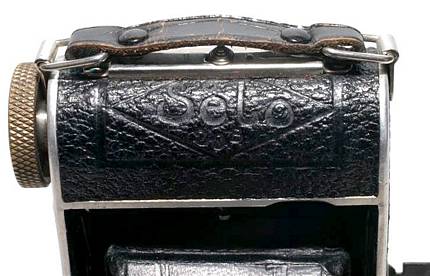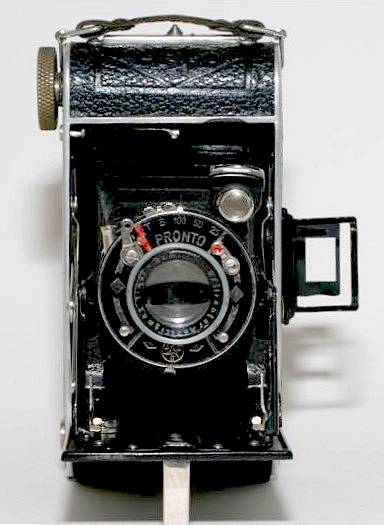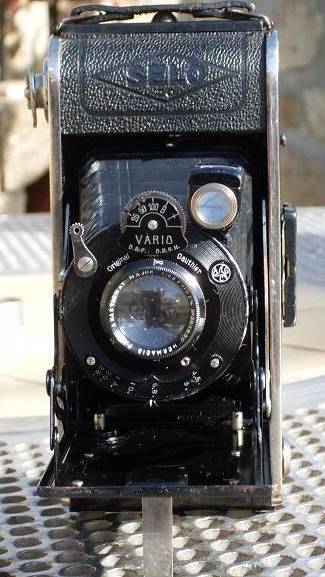| 'Selo' Folding Cameras |
|
|
|
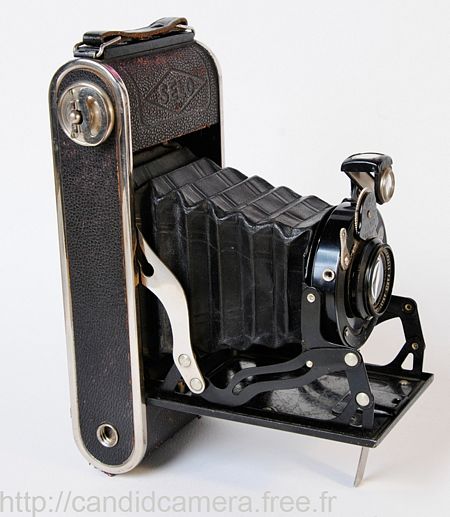 |
The photograph alongside has kindly been supplied to me by a Fench gentleman named Régis Boissier of Lyon. He is currently (November 2012) selling this camera on the French ebay site. It appears to be the same model as the one owned by Daniel Clement (see below). The description is: Folding camera brand SELO 20; |
|
I first became aware of the existence of a folding camera bearing the name SELO, within an embossed diamond frame, very similar to the Ilford Selo film brand, when a gentleman named Richard Wellborne contacted me in July 2009. He was wishing to sell the first of the cameras shown below and asked me if I had any information about it. I coudn't help him, but he nonetheless gave me permission to show pictures of his Selo camera on this website. His Selo folding camera was a complete mystery to me. No listings of Ilford cameras make reference to one named 'Selo', though various examples clearly exist, as shown below.
The shutter on Richard Wellborne's camera is a Pronto AGC - meaning Alfred Gauthier Calmbach. The Gauthier firm was founded in 1902 and started building shutters in 1904. They took over production of Compur shutters in 1970. The Pronto shutter is a simple 'self-tensioning' type i.e. there is no pre-tensioning cocking lever; the shutter springs are tensioned by the first part of the downward movement of the shutter release lever. |
|
|
A year later, adding further to the Selo camera mystery, I found this website where, in 2010, another Selo folding camera was displayed. This one also has its Selo name within a horizontal diamond outline, but in this case the name Selo is written in capital letters (exactly as on the film box, above). To view pictures of the Selo camera copied from that site, see the second camera below Under the word SELO is written '20', presumably referring to it taking the Kodak 120 film size; 8 exposures per film, 6.5x11cm. Ilford (of course) also sold such a film size, but called it simply a No.20 (see the yellow Ilford film dispenser shown a short way down on thr right hand side of this page). Thus, it made sense for the camera to be named a SELO 20. This second 'Selo' folder has a French lens, name 'Hermagis', but the shutter is still a German Gauthier, this time a Vario. The Vario offers 1/25th, 1/5th & 1/200th sec exposure times, plus B & T. |
|
|
Some of the mystery surrounding these Selo folding cameras has now been dispelled by an email received (March 2015) from a gentleman named Daniel Clement, who says "I recently purchased a SELO 20 camera absolutely identical to the camera shown in the French website forum belonging to Sylvain Halgand. And I may possibly solve part of the mystery about this item. Firstly, the SELO 20 has been identified as a Wirgin camera, one of their Auta folding camera range, distributed under the name of SELO 20 (the name Auta may be a reference to the folding camera having an automatic push-buton mechanism for lowering its front panel and erecting the taking lens into position for use; in the 1920s, the lens panel of such cameras had to be manually pulled into position after the front panel had been manually pulled open and locked into place). Secondly, this camera came to me with the original user's manual carefully folded in its leather case. This user's manual is in the French language, giving evidence of it being intended for sale in France. An important aspect is that the text of this manual is ended by "Société Anonyme Wellington & Ward". (To see this Manual, scroll downwards). The Wirgin company was founded by the brothers Heinrich, Max and Josef Wirgin in 1920. They introduced their first distinctive camera in 1927, the Edinex, which they also badged as an Adrette, for Adox. The Wirgin Auta range of folding cameras was made between 1934 and 1938, a date range which Clement suggests could equally apply to the Selo range of folding cameras. In 1938 Heinrich and Josef Wirgin were still in charge of their company in Wiesbaden, however the Nazi persecution of the Jews compelled them to escape from Germany. Max had already arrived in the US on May 14th, 1936, and subsequently helped his brothers follow him to America. In their absence, the Wirgin factory in Wiesbaden became incorporated into the Adox photographic company. After the war, Heinrich Wirgin returned to Germany from America, he was then named Henry Wirgin, and refounded the Wirgin company in Wiesbaden. By the mid-1950s, Wirgin were very successfully producing the sophisticated Edixa Reflex range of slr cameras, imported to the UK by Photopia. But the company that had been
named Wellington & Ward had been assimilated into Ilford
Ltd by 1930 (it was the last of the major British photographic
manufacturers to be acquired by Ilford Ltd), so why did the SELO 20
camera's instruction leaflet, dating from the mid-1930s, bear
their name? The Ilford history detailed
within the book "Silver by the Ton" (ISBN 0-07-084525-5,
published by McGraw-Hill, 1979, page 72), says that the French
company, Wellington and Ward S.A., had been running, somewhat
unsuccessfully, for many years. The chronology of this
sentence is not explained, though might imply Wellington &
Ward had set up this French associate company prior to Welington
and Ward being taken over by Ilford. If this wasn't the case,
it would be expected that this French subsidiary, like other
Ilford export companies set up in the 1930s, would have had Ilford
in its title e.g. Ilford Foto Akts (Denmark); Ilford-Selo NV
(Holland); Ilford-Selo SA (Begium). The words "somewhat unsuccessfully" (above) may be the key to explaining the reason why Wellington and Ward S.A. began their association with Wirgin. The naming and distribution of certain Wirgin cameras bearing the film brand name 'Selo' would have encouraged the use of Selo film by the camera purchasers and so would have served to boost the UK export of Selo film to France. Since Wellington and Ward were part of Ilford at the time this Selo camera range was being sold (albeit possibly only in France), the range seems to have a legitimate claim to being a newly found range of Ilford cameras. The Sportsman camera range was made for Ilford in Germany (by Dacora) so the precedent is already there to equally include the Selo Folding Camera range, also made in Germany (by Wirgin). |
|
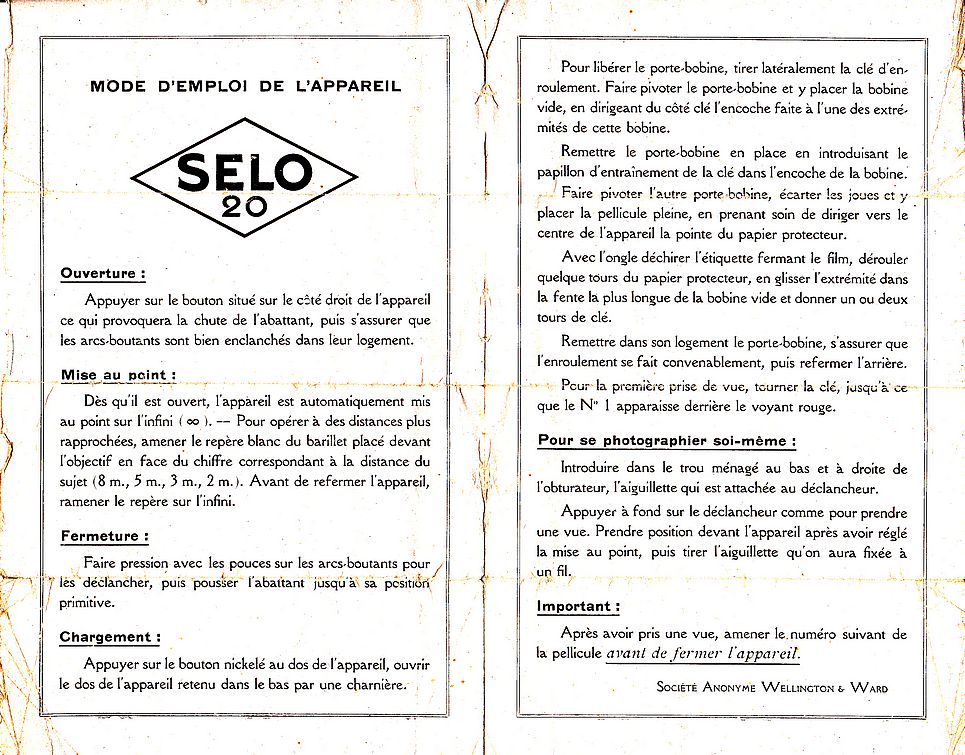 |
|
| Translation: | |
|
I have tried to translate the above, as follows (not word for word translation but an attempt to make it meaningful): Method of Use of the SELO 20 Press the button on the right side of the unit which will cause the front flap to descend and then ensure that the bright metal side supports are fully engaged. Setting it ready for use. Closing the Camera: Film Loading: |
Pull up the winding key, swing
outwards the spool holding chamber and insert the empty spool.
Replace the spool holding chamber in place by inserting the internal
'key' of the wind-on knob into the end notch of the spool. Make
sure the widest side of the longitudinal slot in the empty take-up
spool is facoing towards the opposite film chamber. To photograph yourself (i.e
Using delayed action): Important: |
|
|
|
|
|
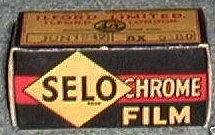 'Selo'
was long used as an Ilford film trade name (1930 to 1960s) and
the horizontal diamond surround to the word Selo (see camera
picture, below left) is very similar to how Ilford applied the
Selo name (see film box, left). The main difference seems to
be that 'Selo' was usually written (by Ilford) using upper case
letters, whereas the embossed name on the first camera below
uses lower case.
'Selo'
was long used as an Ilford film trade name (1930 to 1960s) and
the horizontal diamond surround to the word Selo (see camera
picture, below left) is very similar to how Ilford applied the
Selo name (see film box, left). The main difference seems to
be that 'Selo' was usually written (by Ilford) using upper case
letters, whereas the embossed name on the first camera below
uses lower case.